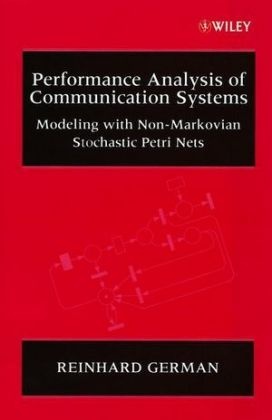Read more
Zusatztext "...an excellent general introduction...a highly recommended source for researchers who are interested in utilizing Petri nets." (Journal of Mathematical Psychology! 2002) Informationen zum Autor Reinhard German is the author of Performance Analysis of Communication Systems : Modeling with Non-Markovian Stochastic Petri Nets, published by Wiley. Klappentext The field of communication systems is full of complex design questions concerning performance and reliability. Since data traffic and errors occur in a random fashion, stochastic models are used for developing and comparing systems. In particular, stochastic Petri nets have become a popular tool for the description and automatic evaluation of such models. The use of non-Markovian models has become important as they allow more flexibility. * Provides a clear exposition of the use of stochastic Petri nets in communication systems engineering * Introduces the reader to the analysis techniques and algorithms used in performance evaluation * Provides an accompanying example to clarify the use of each definition, concept and algorithm * Mathematica routines used for implementing the algorithms are available on the Wiley ftp site The text is divided into three parts. Part I gives a general introduction to modeling with stochastic Petri nets. Part II is devoted to analysis methodology, from simple Markovian, to more complicated non-Markovian models. In Part III non-Markovian stochastic Petri nets are applied to the performance evaluation of various aspects of communication systems. The text will appeal to researchers, industrial engineers and graduate students studying communication systems and stochastic modeling. The numerous examples will benefit those working in performance evaluation, reliability, operations research, queuing theory and computer science. The Mathematica routines used for implementing the algorithms are available for downloading on the following Wiley ftp site: ftp://ftp.wiley.co.uk/pub/books/german Zusammenfassung Petri nets are used for modelling systems with concurrency such as traffic flow within communication systems. This text introduces the analysis techniques and algorithms used in performance evaluation with non-Markovian stochastic petri nets, taking a systematic approach. Inhaltsverzeichnis Foreword Preface Contents Outline Acknowledgments I Modeling with Stochastic Petri Nets 1 Introduction 2 Stochastic Petri Nets 3 Tool Support 4 Preliminaries 5 Markovian Stochastic Petri Nets 6 The Method of Supplementary Variables 7 General State Equations 8 Stationary Analysis 9 Transient Analysis 10 General Execution Policies 11 Reducible Structures 12 Markov Renewal Theory 13 Concurrent Deterministic Transitions 14 Introduction to Communication Systems 15 Medium Access Control 16 Error Control for Noisy Channels 17 Miscellaneous Topics 18 Concluding Remarks Appendix: SPNica Manual A.1 A Short Tour of SPNica A.2 Analysis of Discrete-Time Markov Chains A.3 Analysis of GSPN Models A.4 Stationary Analysis of Non-Markovian SPNs A.5 Transient Analysis of DSPNs List of Abbreviations Glossary of Notation References Index...

